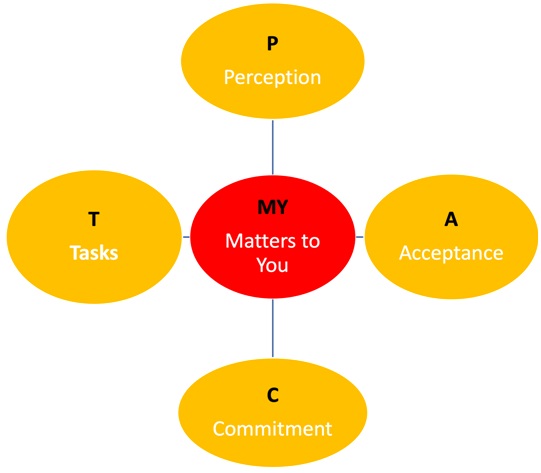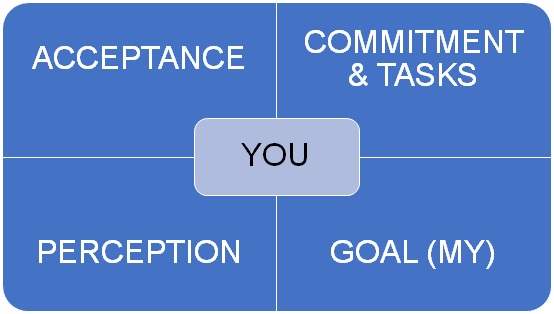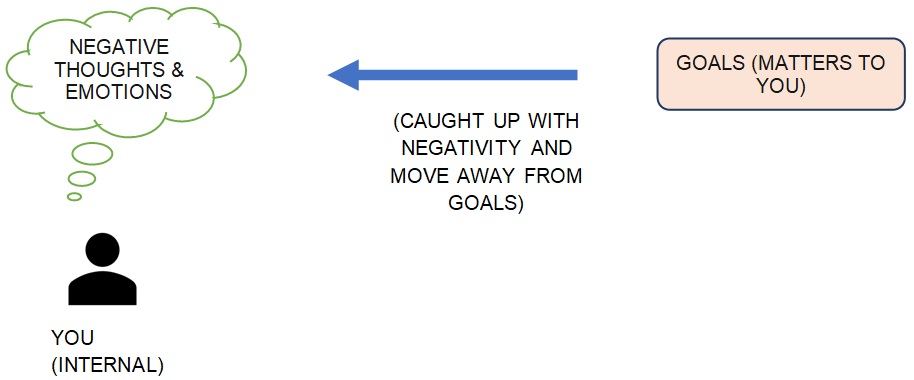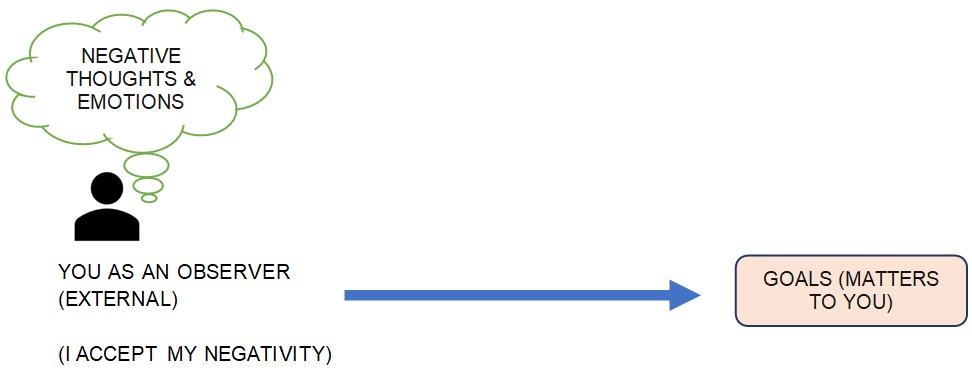A Coaching Model By Austin Tay, Executive Coach, SINGAPORE
Dealing With Negative Thoughts – My PACT
 Sometimes we react to situations because we feel at that moment; it is the correct response. However, we might realize various ways to approach those situations when we can trace back our steps.
Sometimes we react to situations because we feel at that moment; it is the correct response. However, we might realize various ways to approach those situations when we can trace back our steps.
When we are involved in a situation, our minds will process and come out with different thoughts. Some are helpful, while some are not. When we get entangled with unhelpful thoughts, we start to fall into various thinking traps. These traps will perpetuate more unhelpful thoughts preventing us from thinking clearly.
At the same time, in response to our thoughts, we will start to have emotions. Some are positive, while others are not. In addition, negative emotions can manifest themselves, such as frustrations, anger, sadness, and anxieties, impacting the way we react to the situation.
To ensure that we can deal with the unhelpful thoughts and negative emotions, as human beings, we can regulate that through either passive or active actions. Passive actions can include avoiding the situation finding justification for the problem, and procrastination. In contrast, active measures can consist of taking matters head-on, looking for solutions to solve the issue, and finding reasons for the cause. However, sometimes our actions can only make the situation worse. Therefore, to ensure that our efforts can help resolve issues, it is good to have a chance to trace back the steps and look at what we can do differently to solve the situation.
There are two parts in this coaching model, Part 1: MY – Matters to You and Part 2 : P (Perception), A (Acceptance), C (Commitment), and T (Tasks).
Part 1 – Matters to You (My)
Often when we look to achieve something, we will ponder how we will do so. However, before we look at the steps to achieve our goals, we need to consider what matters to us? What matters to us is often viewed as VALUES. To do so, we can ask two questions:
- What is important to me?
- Who is important to me?
When we can answer either of the questions, we will move on to the next step – defining the goal. A goal needs to be meaningful and important to us, and if not, we are likely to give up working towards it.
For example, if the value is
- A promising career is important to me.
- My family is important to me
To help define the goal, we will need to dig deeper into the VALUE, for example,
A promising career is important to me.
Why? – provides for my family; they will feel secure, and I will fulfill my responsibility.
So defining the goal – to be responsible and provide for my family.
Once we established a goal, we will now need to think about potential derailers or motivators that will keep us on track in achieving our goals. To do so, we will look at the Matrix below.
EXTERNAL

INTERNAL
We will take a step-by-step look at each process as delineated in the Matrix above.
As we can see, YOU is in the middle of the MATRIX. So that indicates that we are in the best position to know how the individual quadrants can affect us as an individual.
Goal (Part of the Matters to You Stage)
We set the GOAL in the Matters to You stage. The goal is the focal point with which all the other three quadrants will align.
Perception
Under perception, we will focus on two areas: thoughts (both positive and negative) and emotions (both positive and negative).
For example,
Goal – to be responsible and provide for my family.
Based on the goal, what kind of thoughts surface?
Positive Thoughts
- I have to work very hard to ensure that I am responsible.
- I need to ensure that I do not irresponsibly use my income.
Negative Thoughts
- I am not sure how I can be successful in my work.
- I feel burdened when I think that my family is dependent on me.
On the one hand, the positive thoughts provide us with the fuel to move forward to our goal, and the negative thoughts will reverse. But, on the other hand, negative thoughts will challenge our intentions to fulfill our goals, which creates doubts, fears, and trepidation.
No one wants to have uncomfortable emotions and thoughts, so we do what we know best. We adopt the fight or flight mode. Fighting these negative thoughts and emotions, we adopt strategies such as being overly positive, having distorted cognitive perceptions that “everything is under control”, or avoiding the negative thoughts and emotions altogether (self-deception).
When we have negative thoughts and emotions, we become stuck. All we see is despair and that we are on an endless thread mill that goes round and round. We all, unfortunately, experience this all the time and are too caught up and not able to see how these ruminations can move us further away from our own goals. As a result, we find reasons for not fulfilling the steps required to achieve our goals. Being in this position is fused with our negative thoughts and emotions, considered an internal experience. To enable ourselves to get out from this rut, we need to take a step as an observer, that is, an objective observer, to perceive our situation. In a way creates a safe psychological distance. See the illustration below:
Figure 1 (without perspective)

Figure 2 (with perspective)

Acceptance
Once we can take a perspective (internally) about what is presented to us, we will look at incorporating these two realities on opposite extremes.
Learning to accept that negative thoughts and emotions as part of the process we will encounter as we work towards our goals can be daunting. Unfortunately, this acceptance does not mean that the negativity we experience will disappear. Although we are learning to recognize that our negativity will constantly challenge us, we tell ourselves we have yet another choice and accept it.
Acceptance here also means that we know that our negativity is lingering somewhere within us; we need to know how not to let the negativity take control. A few ways we can adopt are: naming the negative thoughts and emotions; being aware of their existence, and when they are bubbling up to the surface, we go back to perspective-taking; be in control, that is to have that internal conversation with the negative thoughts and emotions such as, ‘Thank you fear, but you are not going to stop me from moving towards things that matter to me.’
Recognizing that when we feel and think negatively, we only exacerbate our emotions and thoughts by associating with words. They are only words! As the adage goes, ‘sticks and stones can break my bones, but words can never hurt me.’
Learning to accept negativity means that we will be using less time to ruminate about them. In doing so, we essentially allow ourselves to refocus our attention and time on people around us, to things that we enjoy doing, and simply being in the moment. One way we can help ourselves to create such awareness is to slow down, meditate and be still. Doing all these help us to have clarity, insights, and also renewed perspective. (See Figure 3)
Figure 3 (with acceptance)

Commitment and Tasks
When we have accepted that we will have to work with our negative thoughts and emotions, this is the time that we start to commit ourselves to move towards our goals. It has to be clear that while committing to our goals can be easy, we also need to understand that with good intentions, sometimes we are faced with things that we might not have control over. Something we have no control of include time, people, and unforeseen circumstances. Just like traveling on a journey, we can get distracted and veer off our itinerary. When we do not stay on course, we need to cut ourselves some slack and not beat ourselves up for not sticking to the journey. Let us put it in another perspective; the distraction can be the way the universe is telling us to take a pause and reflect. So it is ok to feel that we might not have progressed at the rate we have set for ourselves. It is ok at this juncture to show ourselves self-compassion.
Setting tasks to complete is very important for us to achieve the goals we set for ourselves. Often people give up pursuing their goals because they find it too hard to complete the tasks. One golden rule, whenever we set tasks to achieve, they must be (S) specific (M) measurable, (A) achievable, (R) realistic, and (T) time-bound – SMART. When we can achieve the tasks we set ourselves, we are motivated to complete more tasks. (See Figure 4)
Figure 4 (with commitment and tasks)

The Full Cycle
It is inevitable for us, as humans, to experience negativity. Such experience is a response that we believe must conform to society’s standards, culture, upbringing, and consistent experience as we interact with people. However, to live our lives following our values, we need to accept that our thoughts and emotions will be challenged or even sabotaged. So we need to seek out that lighthouse (values) that will guide our path as we navigate through the different stages (actions) of our journey.
Learn How to Create Your Own Coaching Model
Your Coaching Model reflects your values,
philosophies and beliefs and must communicate who you will coach
and the problems you will solve. Read more about creating your coaching model
References
Hayes, S.C., Strosahl, K.D., & Wilson, K.G. Acceptance and Commitment Therapy. Guildford Press.
Polk, K. L., Schoendorff, B., Webster, M., &Olaz, F. O. The essential guide to the ACT Matrix: A step-by-step approach to Using the ACT matrix model in clinical practice. Oakland, CA: New Harbinger Publications.
Oliver, J., Hill, J., & Morris, E. Activate Your Life: Using Acceptance and Mindfulness to Build a Rich Life, Fulfilling and Fun. London, England: Constable & Robinson.